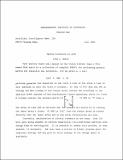| dc.description.abstract | Very shortly there will appear on the vision library tape a field named @IAS which is a collection of compiled SUBR"s for performing general matrix row reduction and inversions. For an array A a call (IAS A NEW N M) performs gaussian row reduction on the first N rows of the array A (and in fact operated on only the first M columns); so that if M>N then the N+1 st through the Mth columns of the output array contain the solutions to the implicit M-N+1 systems of NxN simultaneous linear equations, while the first N columns contain the inverse matrix of A11 ANN. If the NEW is "T" then a new array of size NXM is declared and the answers are stored directly over the input array and no new array declarations are done. Currently, maximization of pivotal elements is not done; thus IAS will give wrong answers on certain numerically ill-conditioned matrices even though they be non-singular. It is possible to remedy this problem, at some expense, if necessary. IAS also uses a portion of binary program space for temporary storage and may give an error message if not enough space is available. | en_US |

